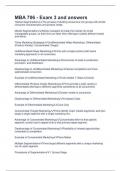MBA 706 - Exam 3 and answers
Market Segmentation✔✔The process of dividing consumers into groups with similar
consumer characteristics and product needs.
Market Segmentation✔✔Allows managers to break the market into small
manageable groups, so that firms can tailor their offerings to satisfy different needs
and wants.
Three Marketing Strategies✔✔Undifferentiated (Mass Marketing), Differentiated
(Product-Variety), Concentrated (Target)
Undifferentiated (Mass Marketing)✔✔Firms sell a single product (with same
marketing approach) to all consumers.
Advantage to Undifferentiated Marketing✔✔Economies of scale in production,
promotion, and distribution
Disadvantage to Undifferentiated Marketing✔✔Intense competition and more
sophisticated consumers
Example of Undifferentiated Marketing✔✔Ford's Model T, Black & Decker
Differentiated (Product-Variety Marketing)✔✔Firms provide a wide variety of
differentiated offerings to different segments (sometimes to all consumers).
Advantage of Differentiated Marketing✔✔Greater variety to consumers
Disadvantage of Differentiated Marketing✔✔Increased Costs
Example of Differentiated Marketing✔✔Coca-Cola
Concentrated (Target) Marketing✔✔Firms identify major market segments, and then
target a single segment with a single marketing mix.
Advantage of Concentrated Marketing✔✔Concentrated effort to that specific
segment; control cost to appeal only to that primary target segment.
Disadvantage of Concentrated Marketing✔✔Possibility of missed opportunities;
vulnerable to competition.
Example of Concentrated Marketing✔✔Piano Maker
Multiple Segmentation✔✔Firms target different segments with a unique marketing
mix for each segment.
Procedures of Segmentation✔✔1. Survey Stage
, 2. Analysis Stage
3. Profiling Stage
Survey Stage✔✔understand consumer motivations, attitudes, and behavior
Analysis Stage✔✔identify consumer groups with similar characteristics
Profiling Stage✔✔Profile each group in terms of their attitudes, behavior,
demographics, psychographics and media habits
Factors affecting the feasibility of segmentation✔✔A marketing segment must be:
measurable, accessible, substantial, unique, appropriate, and stable
Bases for Segmentation✔✔•Geographic and geodemographic
•Demographic
•Behavioral
•Psychographic
Geographic✔✔One of the easiest and most commonly used methods. Markets are
divided into groups based on region, climate, population density.
Geodemographic✔✔Combine geographic and demographic factors. Target
consumers in particular areas with similar behavior patterns - "Birds of a feather flock
together"
Demographic✔✔Markets are divided using demographic variables such as income,
age, gender, educational attainment, occupation, religion, race, nationality,
family/household characteristics, etc.
Behavioral✔✔Markets are divided based on behavioral measures such as attitudes,
knowledge, benefits sought, willingness to innovate, loyalty status, usage rates, etc.
Benefit Segmentation✔✔Based on the benefits that consumers seek from a product.
Ex: Toothpaste segmentation based on benefits like teeth whitening, cavity
protection, etc.
User Status✔✔Markets can be divided on the basis of user status, including non-
users, first-time users, and regular users.
Loyalty Status/Brand Enthusiasm✔✔Markets are divided on the basis of the extent
and depth of their loyalty to particular brands or stores. Ex: Airline frequent flyer
programs.
Psychographic✔✔Markets are divided using psychographic characteristics such as
personality, value, lifestyle, etc. Ex: Car manufacturers; Gap (BR, Gap, Old Navy,
Athleta, Hill City, Janie and Jack).




